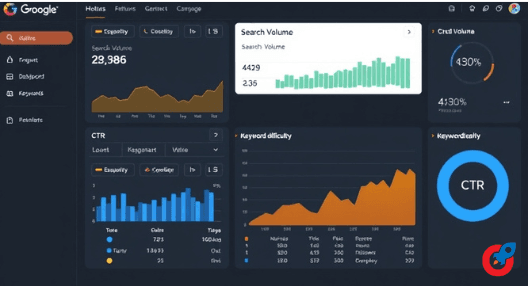SEO Power Play: Chapter 2. – Keyword Research and Strategy
In the world of digital marketing and search engine optimization (SEO), a strong keyword strategy is the cornerstone of a successful online presence. Whether you are running a blog, e-commerce site, or corporate website, knowing how to strategically incorporate keywords into your content is crucial for driving organic traffic and achieving higher search engine rankings. This article will explore the process of creating an effective keyword strategy, providing actionable insights and techniques to help you optimize your content and improve your website’s visibility on search engines.
Table of Contents
Understanding the Importance of a Keyword Strategy
Before diving into the specifics of creating a keyword strategy, it’s essential to understand what keywords are and why they are important. Keywords are the specific terms or phrases that users type into search engines like Google when looking for information, products, or services. By targeting the right keywords, you can ensure that your website appears in front of users actively searching for the content you offer.
The importance of a well-crafted keyword strategy lies in its ability to attract relevant traffic. For instance, if your website is optimized for the wrong keywords, it may attract visitors who are not interested in your product or service, resulting in high bounce rates and low conversion rates. On the other hand, targeting the right keywords ensures that your content aligns with user intent, driving more qualified leads and ultimately boosting conversions.
In short, a well-thought-out keyword strategy can be the difference between a website that languishes in obscurity and one that ranks high on search engine results pages (SERPs).
Step 1: Define Your Goals

Creating an effective keyword strategy starts with defining clear goals. Without a concrete understanding of what you want to achieve, it will be difficult to select the right keywords and measure the success of your efforts. Some common goals for SEO and keyword strategy include:
- Increasing Organic Traffic: By targeting high-volume keywords, you can drive more visitors to your site from search engines.
- Improving Search Engine Rankings: If you aim to improve your rankings for specific search terms, a keyword strategy can help you focus your efforts on ranking higher for those terms.
- Enhancing Conversion Rates: Choosing the right keywords can help attract users who are more likely to convert, whether that means making a purchase, signing up for a newsletter, or completing another desired action.
- Expanding Your Brand’s Reach: A good keyword strategy can help you expand your reach by targeting long-tail keywords that attract niche audiences or broader, more competitive keywords for greater visibility.
Identifying your goals at the outset will guide your keyword research and ensure that your strategy is tailored to meet your specific needs.
Step 2: Conduct Comprehensive Keyword Research

Keyword research is the foundation of any effective keyword strategy. By understanding what your audience is searching for, you can select keywords that align with user intent and are relevant to your business. To begin your research, consider the following methods:
Use Keyword Research Tools
There are a variety of keyword research tools available to help you discover potential keywords for your strategy. Some of the most popular tools include:
- Google Keyword Planner: A free tool provided by Google Ads, Keyword Planner offers keyword suggestions and helps you estimate search volume and competition for each term.
- SEMrush: This comprehensive SEO tool offers keyword research, competitor analysis, and detailed data on keyword rankings, making it ideal for discovering high-performing keywords.
- Ahrefs: Known for its detailed keyword data and backlink analysis, Ahrefs can help you identify keywords that are both relevant and have a manageable level of competition.
- Ubersuggest: Ubersuggest offers keyword suggestions along with data on search volume, competition, and SEO difficulty.
Analyze Competitor Keywords
One effective way to discover valuable keywords is by analyzing your competitors’ websites. Tools like SEMrush and Ahrefs allow you to input your competitors’ domains and view the keywords they rank for. By understanding which keywords are driving traffic to your competitors’ sites, you can uncover new opportunities for your own strategy.
Focus on Long-Tail Keywords
While broad, high-volume keywords can drive substantial traffic, they are often highly competitive and difficult to rank for. Long-tail keywords, on the other hand, are more specific phrases that tend to have lower search volume but also less competition. They are often better suited to niche audiences and are more likely to drive conversions since they reflect more specific search intent.
For example, instead of targeting the broad keyword “shoes,” a long-tail keyword might be “best running shoes for flat feet.” This phrase is more specific, likely to have less competition, and more aligned with user intent.
Step 3: Analyze Keyword Metrics

Once you have a list of potential keywords, it’s time to analyze them based on important metrics. Understanding these metrics will help you prioritize which keywords to target in your strategy.
Search Volume
Search volume refers to the number of times a keyword is searched for within a specific period, usually per month. Keywords with high search volume indicate that there is a significant interest in that topic. However, as previously mentioned, high-volume keywords can also be highly competitive, so it’s essential to balance volume with competition.
Keyword Difficulty
Keyword difficulty (or keyword competition) is a metric that estimates how hard it will be to rank for a particular keyword. It’s typically expressed as a score, with higher numbers indicating more competition. Keywords with low difficulty and a reasonable search volume can often be a great target for your strategy.
Click-Through Rate (CTR)
CTR indicates how likely it is that users will click on a search result for a particular keyword. This metric is essential for evaluating the effectiveness of your keywords, as it reflects how engaging and relevant your content will be to users searching for those terms.
Step 4: Group Keywords by Intent

Once you have gathered a list of potential keywords, it’s important to categorize them based on user intent. Understanding the different types of search intent will help you tailor your content to meet the needs of your target audience.
There are typically three main types of search intent:
- Informational Intent: Users are looking for information or answers to specific questions. These searches usually include phrases like “how to” or “what is.” For example, someone might search for “how to create an effective keyword strategy.”
- Navigational Intent: Users are looking for a specific website or page. This type of intent includes searches for brand names or website URLs, such as “Nike official website.”
- Transactional Intent: Users are ready to make a purchase or complete an action. Keywords with transactional intent often include phrases like “buy,” “discount,” or “order.” For example, a search for “buy running shoes online” indicates transactional intent.
By categorizing keywords based on intent, you can tailor your content to meet the needs of users at different stages of the buying journey, whether they are seeking information, evaluating options, or ready to make a purchase.
Step 5: Implement Keywords Strategically

Once you’ve identified your target keywords, it’s time to implement them strategically across your website. Proper keyword placement is essential for SEO, as it helps search engines understand the relevance of your content to specific queries. Here are some tips for effective keyword implementation:
Use Keywords in Key Areas
- Title Tags: Include your primary keyword in the title tag of each page. This is one of the most important on-page SEO elements.
- Meta Descriptions: Use your target keyword in the meta description to help improve CTR.
- Headings: Incorporate keywords into headings (H1, H2, etc.) to signal the relevance of the content.
- Content: Naturally incorporate keywords throughout your content, ensuring that they align with user intent. Avoid keyword stuffing, which can negatively impact readability and SEO.
- Alt Text for Images: Include descriptive keywords in image alt texts to improve image search rankings.
Avoid Keyword Stuffing
While it is important to use keywords, avoid overusing them in a way that disrupts the flow of your content. Keyword stuffing can lead to penalties from search engines, negatively impacting your rankings. Aim for a keyword density of around 1.5% to 2%, ensuring that your keywords are integrated smoothly into the content.

Step 6: Monitor and Adjust Your Strategy
Creating a keyword strategy is not a one-time task. SEO is a dynamic field, and keyword trends and search behaviors can change over time. To stay ahead of the competition, regularly monitor the performance of your keywords using tools like Google Analytics, SEMrush, or Ahrefs. Track metrics such as organic traffic, rankings, and conversion rates to assess the effectiveness of your keyword strategy.
If certain keywords are underperforming, consider revisiting your keyword research and adjusting your strategy accordingly. This could involve targeting different keywords, optimizing your content further, or improving your website’s technical SEO.
Conclusion
Creating an effective keyword strategy is crucial for achieving long-term success in SEO. By carefully selecting the right keywords, grouping them by intent, and strategically implementing them on your website, you can drive relevant traffic, improve your search engine rankings, and ultimately boost conversions. Remember that SEO is an ongoing process, and your keyword strategy should be flexible to adapt to changes in user behavior and search engine algorithms.
An effective keyword strategy is the foundation of any successful SEO campaign, and by following these steps, you can ensure that your website attracts the right audience, increases visibility, and achieves your digital marketing goals.
For further reading on keyword strategy, consider exploring reputable resources like Moz, Ahrefs Blog, or SEMrush Blog for in-depth guides and tools to enhance your SEO efforts.

